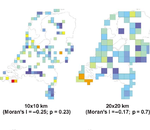Abstract
We test whether temporal change in species richness (ΔS [%]) is scale-dependent, using data on hoverflies from the UK and the Netherlands. We analysed ΔS between pre-1980 and post-1980 periods using 5 grid resolutions (10×10, 20×20, 40×40, 80×80 and 160×160 km). We also tested the effect of data quality and of unequal survey periods on ΔS estimates, and checked for spatial autocorrelation of ΔS estimates.
Using data from equal survey periods, we found significant increases in hoverfly species richness in the Netherlands at fine scales, but no significant change at coarser scales indicating a decrease in beta diversity. In the UK, ΔS was negative at fine scale, near zero at intermediate scales, and positive at coarse scales, indicating that the degree of spatial beta diversity increased between the time periods. The use of unequal survey periods (using longer periods in the past to compensate for lower survey intensity) tended to inflate past species richness, biasing ΔS estimates downwards. High data quality thresholds sometimes obscured dynamics by reducing sample size, but never reversed trends. There was little spatial autocorrelation of ΔS, implying that local drivers (land use change or environmental noise) are important in dynamics of hoverfly diversity. A second, sample agglomeration approach to measure scaling resulted in greater noise in ΔS, obscuring the NL pattern, while still showing strong evidence of fine-scale richness loss in the UK.
Our results indicate that explicit considerations of spatial (and temporal) scale are essential in studies documenting past biodiversity change, or projecting change into the future.
